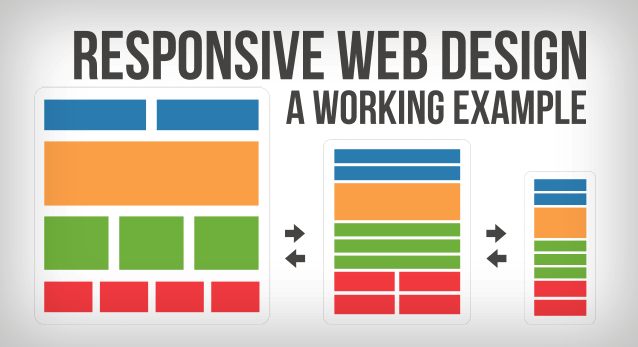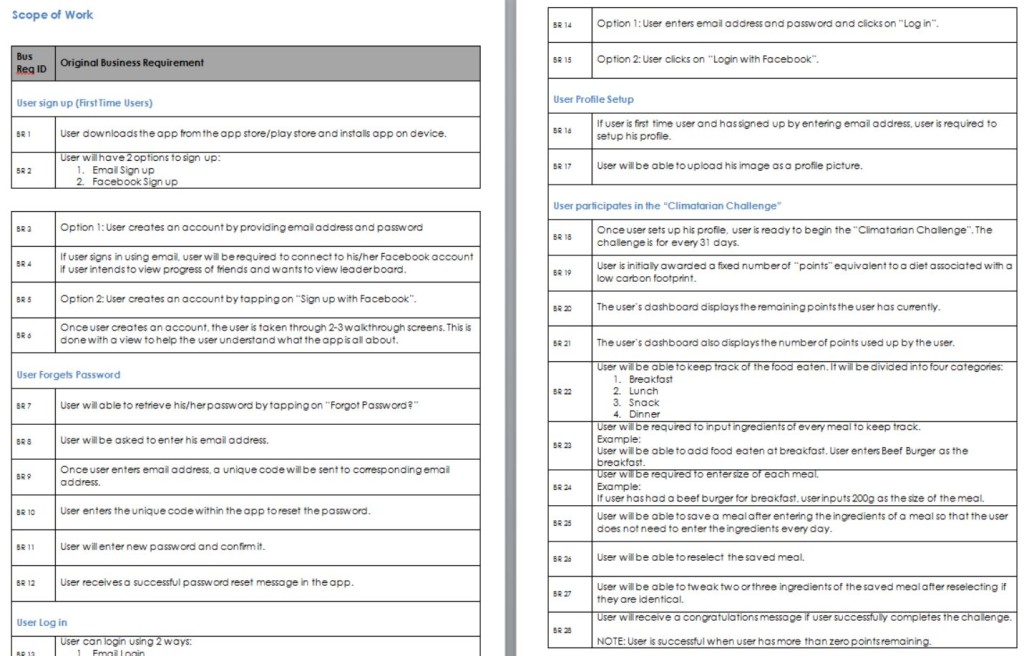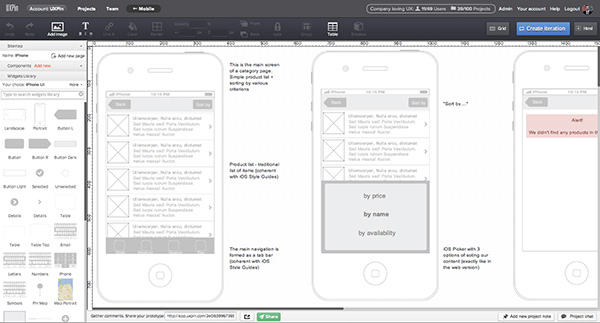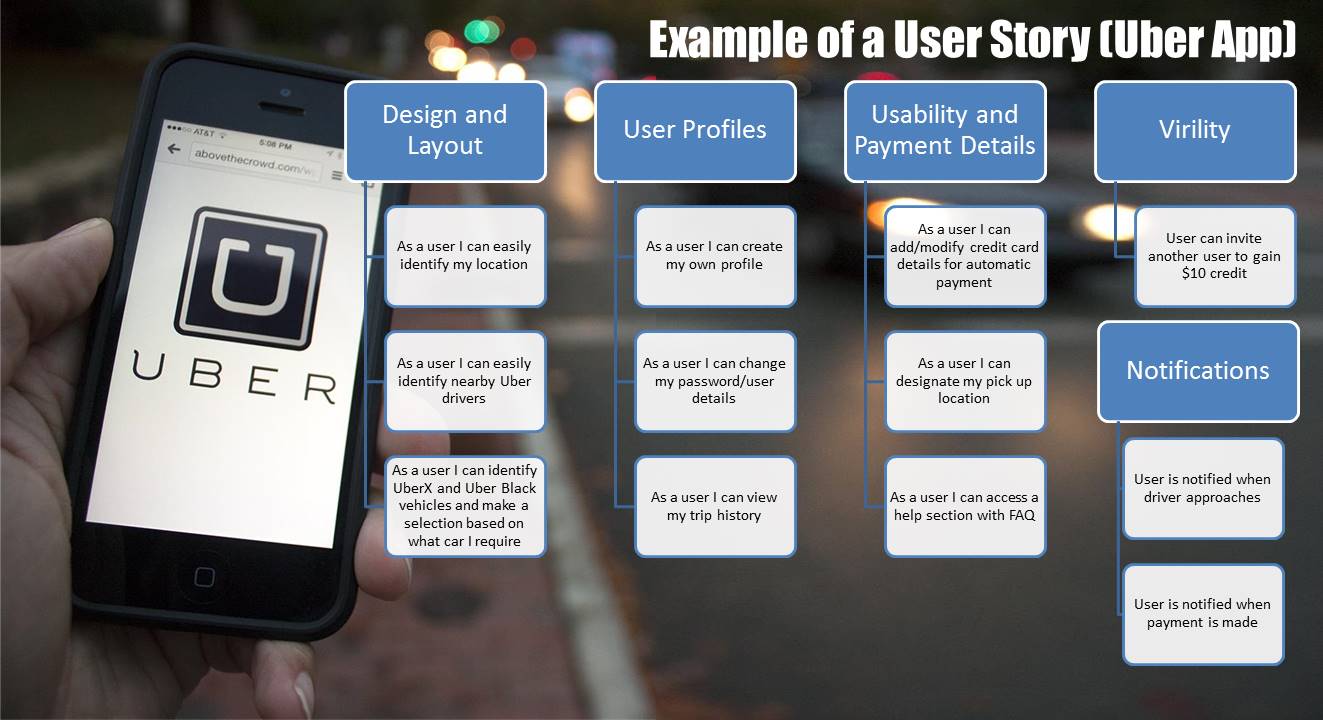Free resources for app creators
App Virality: Get Your Existing Users Advertise Your App
App Virality – Every marketer dreams that his marketing campaign goes viral. The most successful apps are the ones that spread like a virus. They leveraged their existing users to advertise the app to new users.
The concept of ‘Viral marketing’ was first popularised by Hotmail in 1995 when they put “‘PS: I love you. Get your free e-mail at Hotmail” in the footer of every user’s email. This allowed them to reach a stage where the service was adding 270,000 new users every single day. In Dec 1997, Sabeer Bhatia sold the service to Microsoft for $400 million.
The key distinction of viral marketing is this. Traditional marketing follows the shape of a funnel, channeling from more users to fewer users. Example 1000 users see your ad, 100 click the ad, 1 download the app. But viral marketing follows the shape of an inverted funnel, working from few to many users. 1 user download the app, that user invites 10 users, the 10 users invite 10 users each and the funnel gets wider and wider.
Viral marketing is the phenomena when people actively spread a product or service to others either voluntarily or involuntarily. In the Hotmail example, it was involuntary. Users spread the service just by using the service. App virality is a becoming the trend, one such example is a video-sharing app, TikTok which hit 1 billion downloads in the App store within a few months of launch.
Viral marketing can also be created artificially by creating a clear need or incentive for a user to invite other users.
Create viral loops – App Virality
Some of the world’s greatest apps have been built with incentives for their users to invite more users. For example, Dropbox offers free storage when a user invites a friend to create a Dropbox account. Uber gives you taxi credit when you share your experience with your friends and invite them to use the service. AirBnB offers hosts money for introducing new hosts to AirBnB.
What feature can you build into your app to create this viral loop?
This is a very hot topic in-app marketing, and you can find plenty of books, articles, and websites on this topic if you google “viral loops”.
Build a network effect:
The network effect is a phenomenon where a product becomes more valuable and useful when more people use it. Facebook is a great example: you love it, even more, when all your friends are there participating with you. Whatsapp is more useful when all your friends and family, local and international, are using it, as it makes communication quicker and easier.
Network effect motivates users to invite their contacts to use an app because it will make the app even more valuable for them… and because it’s fun to share.
Does your app make use of network effect?
Does it have a feature that makes the app more valuable to a user when they have friends, family, a colleague using the app?
Keep in mind that all of this work only when your product is great. Creating viral loops and network effect are just two more possibilities for successful marketing that will add to your success and position you to produce that next great app idea that’s rattling around in your brain.
For other promotional techniques, see our posts on advertising, celebrity endorsement, and forming strategic partnerships.
Responsive Web vs Native Apps: What’s right for you?
Recent years have seen a massive uptake of mobile applications by users. Therefore, having a mobile presence either as responsive web or as native apps has become a necessity for businesses rather than it just being a competitive advantage. Any business that does not have a mobile presence stands the risk of losing potential customers/users to its competitors.
In fact, many large companies like Uber adopted a mobile-first approach i.e. Uber developed its mobile app and built a business around it without ever building a website with all the bells and whistles that the app has. Having said that, there are companies like Facebook that start off as responsive web applications and then after generating enough revenue, delve into creating a mobile app to support their business.
However, even with a strong understanding of the need to have a mobile presence, entrepreneurs and businesses may find adapting an entire business to go mobile only – quite a task and often quite confusing.
So when you do decide to build your own mobile app, where do you invest? Do you invest in building a responsive web app or go directly to building a native app? To answer this question, we need to have a clear understanding of what “responsive web apps” and “native apps” are.
Are responsive web apps better than native apps or is it the other way around?
The answer to this question is: It depends.
There are a number of parameters that can help you throw light on what approach is the best for you. A few key factors are:
- Cost
- Time
- Quality
- Functionality
Let’s explore responsive web vs native apps in greater detail.
Image credit
Promote your app while standing on the shoulders of the giants
Partnering with big companies is proving to be a very effective, efficient method for startups to acquire users. It’s not David versus Goliath; it’s David befriending Goliath. Building a strategic partnership allows you to leverage millions of dollars and years of work a corporation has put into their own marketing to help you promote your product. It creates a mutually beneficial business relationship.
Choosing a Strategic Partner
There are four basic elements to look for when considering a strategic partner.
Similar target market:
Look for companies that serve the same market as yours. For example, let’s say your app targets, young parents. Think about partnering with toy companies or local child care centers.
Shared values:
You can start a partnership with any company if you hustle. But for the partnership to be successful in the long term, you need to partner with a company that has similar values. For example, if you value people over profits and your partner values profit over people, it’s not going to be too long before the partnership face challenges.
Common mission:
If you partner with someone who has a similar mission, it will be much easier to get things going in the right direction. For example, Alibaba’s mission is to make it easy to do business anywhere. Jack Ma, the founder of Alibaba, said ‘company mission’ is the first thing he looks when partnering with other companies. He only partners with companies which also strive to make it easier to do business.
Value for your partner:
Think about which company can leverage the most value from your startup. Value can come from any number of factors, but assuming you are a tech startup, often your product can offer unique technology. Target companies who can offer additional value to their customers using your technology.
Examples of Strategic Partnership between App Startups and Big Brands
- One great example of a strategic partnership is an online music app Spotify. It partnered with Adidas to create the Adidas Go app, which uses Spotify’s extensive library to play music according to the pace and intensity of the user’s workout. The partnership provided unique technology for Adidas, and access to hundreds of thousands of Adidas customers for Spotify.
- Uber is the king of partnership. In its early days, Uber partnered with different event companies running big conferences and expos in major cities. Uber would offer conference participants a discount code to use Uber, and get the event companies to send email to thousands of their visitors about the offer. Uber worked with Google to put Uber on Google Maps when users search for their destination. This partnership put Uber in front of millions of new users. Launched November 30, 2012, in Australia, Uber exceeded the one-million-user mark in 2016.
- Buzzfeed, an app that provides personalized news to users, partnered with GroupM, one of the world’s largest distributor of online ads. GroupM provided significant advertising for Buzzfeed in exchange for access to Buzzfeed’s unique Pound technology, which provides user analytic data of how stories spread on the social web.
- Hipstamatic, a photography startup, partnered with Instagram. Users take and edit photos in Hipstamatic and push them to Instagram. These photos have a ‘Taken with Hipstamatic’ tag that links to the Hipstamatic website. Hipstamatic gained exposure to millions of Instagram users. Instagram CEO and co-founder Kevin Systrom said, “Really, it all comes down to this: people post Hipstamatic photos on Instagram all the time, and we just want to make that experience easier.”
- Unidesk provides software to deploy Windows apps. It partnered with Dell, and Dell included the software as part of its solution offering in Desktop Virtualisation Solutions. Unidesk’s unique technology added value to Dell’s existing customers; Unidesk gained access to Dell’s millions of customers.
So, who are your potential targets for a strategic partnership? What do you have to offer? How do you benefit?
Once you make a hit list of companies, identify people in those companies. Linkedin is probably the best tool to research, identify and contact senior people in big companies. With the Linkedin premium plan, you can send inmail to people outside your network. Be a great networker. Go to events and conferences where people from your hit list of companies might attend. Introduce yourself and offer to buy a coffee. Once you meet them, ask who the right person to talk about the partnership is. Work your way in.
Things to consider when documenting your app idea
Many “App-renuers” approach us with a great ideas.
The most common question in our industry is how long and how much money will it take to build an app?
The answer sadly isn’t “$15,000 and we can build any app” instead we generally explain to them that answering “how much does an app cost?” is just as difficult as answering “how much does a house cost?”.
- How many rooms will the house have?
- What material will it built out of?
- What suburb will it be built in?
- How many levels/stories will it have?
- Does it include an elevator or escalator
Similarly, questions like;
- How many devices will the app be built on ie. Apple, Android, Windows, Website?
- How many different types of users will use the app? Using Uber as an example this could be Passengers, UberX drivers, Uber Black drivers, Uber Admin/Staff logins, etc?
- Will people have to make payments via the app?
- Does it connect with any external software ie. Bluetooth devices, sales inventory systems, social media platforms, CRM or accounting systems, etc?
- Will it use GPS functionality?
Would all alter the final cost and time frame required to build an app.
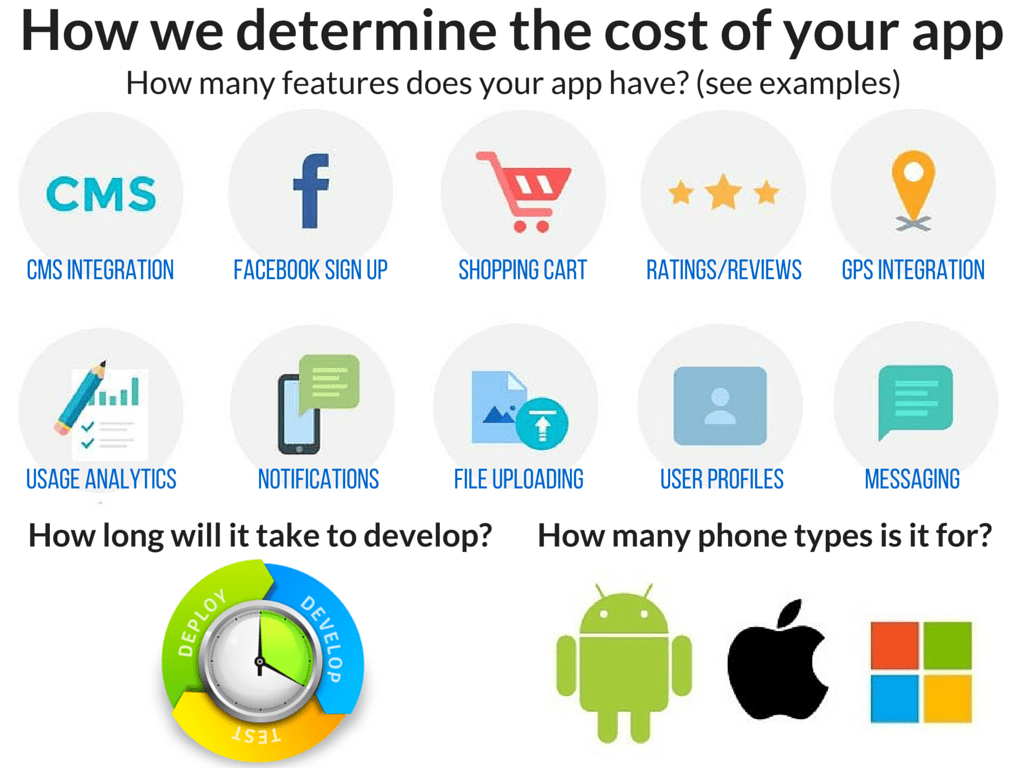
The next step will be for us to understand how your app will be used and how users will experience the app once it is completed.
There are a number of ways we’ve had clients present their idea to our development team.
Below I have listed some examples of the ways clients have presented this information to us in the past which have worked well.
1. A list of features or functions the app will have and an explanation of the problem the app will solve.
This one is easy, simple compile a list of all the features you think your app will have ie. GPS, in app payments, user registration, social media integration, uploading videos/photos, etc. This will give us somewhere to start.
Combine that with the core problem your app has been developed to solve and this is a great starting point to start working on your idea.
Once this is complete our team can work with you to create a scoping document (click to view .pdf of our sample Business Requirement Document – BRD). This will clarify as many of the app requirements as possible and allow for a concise estimate on the time and budget required to build it.
2. Sketch what the screens of your app will look like.
This is a great way to communicate your app idea with our developers.
Putting together a visual representation of your app idea allows you to finalise the things you’ve been thinking as well as give our team the ability to understand what concepts are in your mind.
This process has been proven to remove a lot of guesswork and will save you a lot of time and money by doing so.
It doesn’t have to be a work of art, as seen by this example below, but it will be instrumental in communicating your idea to others.
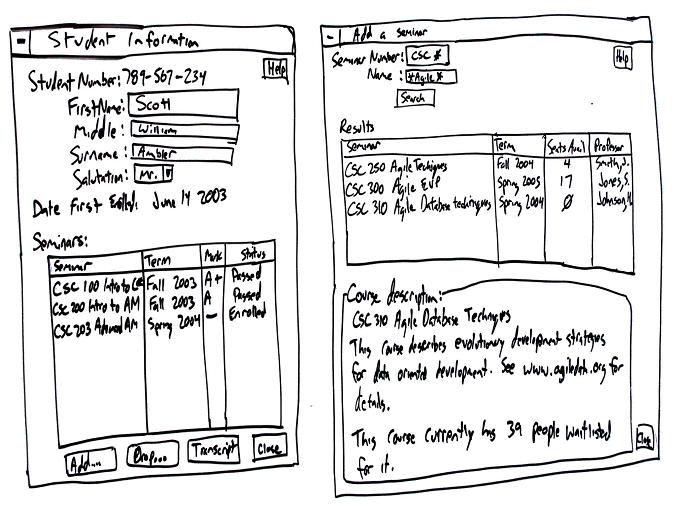
If you’d like to go even further a number of app prototyping tools are available online. uxpin.com, invisionapp.com, marvelapp.com are all very useful tools that clients of ours have used to help convey their message to our development team.
Example shown below.
Once this is complete our team can use this to develop wire frames of your app. This will clarify as many of the app requirements as possible and allow for a concise estimate on the time and budget required to build it.
3. Complete a user story
If you’re more of an analytical person than an artistic one perhaps you could try putting together a user story which outlines the things users will be able to do with your app.
Below we have mocked up a basic example of what a user story would look like for the Uber app.
Once this is complete our team can use this to develop wireframes and UI (user interface) designs for your app.
This will clarify as many of the app requirements as possible and allow for a concise estimate on the time and budget required to build it.
Any of these methods of documentation will help a developer understand your project requirements better. What method you choose to share with us your information doesn’t really matter, however, the more detail you are able to provide in your documentation the faster your app will be developed.
Additionally,there are a number of blogs on our website which will really help to understand what is important while building an app and what the next steps will be.
I encourage you to read through them as they will be very useful as you take the first steps to documenting your app.
The First 3 Things to Consider When Building An App
What Would It Cost To Build Uber, Twitter, Facebook and Instagram Today?
Start Your App Journey Without Spending Any Money
Our next step will be to take your documentation and compile a list of assumptions/concerns our team would have to make/address to create your app. From here we will inch closer and closer to developing a clear blueprint for your app so it can be developed by our team.
But your next step is to complete that documentation… we’re looking forward to going through it with you, so get onto it now and let’s make this happen!
Why building an app for $15,000 is like eating from a buffet instead of a chef
It can be quite confusing to go out and get an estimate for your app idea with quotes. It’s not uncommon for an app developer to quote $0-$15,000 to build your app and the next call resulting in being told your app could be $50,000-$100,000 to complete.
How can paying for a developers time differ so greatly?
Just like ordering a meal, the cost differs greatly due to what you goes into it, this holds true for developing your app.
At Appomate we don’t build $15,000 apps, the reason being we don’t want to build an app that doesn’t succeed. But some people can build $15,000 apps, so how is that possible?
Think about going to an “all you can eat” buffet, perhaps something like Pizza Hut, Sizzlers or Smorgies.
At these smorgasbord restaurants, you can head to the bain-marie’s and grab a slice of pizza, some honey chicken or perhaps some beef curry and eat away.
- But what if the pizza has anchovies and you don’t like fish?
- What if the honey chicken was cooked with MSG?
- What if the curry had a nut base and you’re allergic to nuts?
At the buffet restaurant, there’s not much you can do about it. You can eat all the food you want there, you just have to eat it the way they make it. This is how a developer can build an app for $15,000.
Cheaper app developers can complete an app for $15,000 because they generally are a one man operation who repeatedly uses a pre-existing backend for their clients. The makes things easy to build as 50% of the app is using pre-existing materials.
The first issue with this is how can one man be an expert in all the skills required to build a successful app and yet price his app development at the cheapest price in town?
- App Design
- App Development
- UI (User Interface)
- UX (User Experience)
- App Feasibility
- App Marketing and Release Strategies
When you build a house you don’t get one guy to do it, you need a team of contractors. Electricians, Plumbers and Carpenters and apps are no different.
Developing any app requires at bare minimum four clearly distinct skills sets.
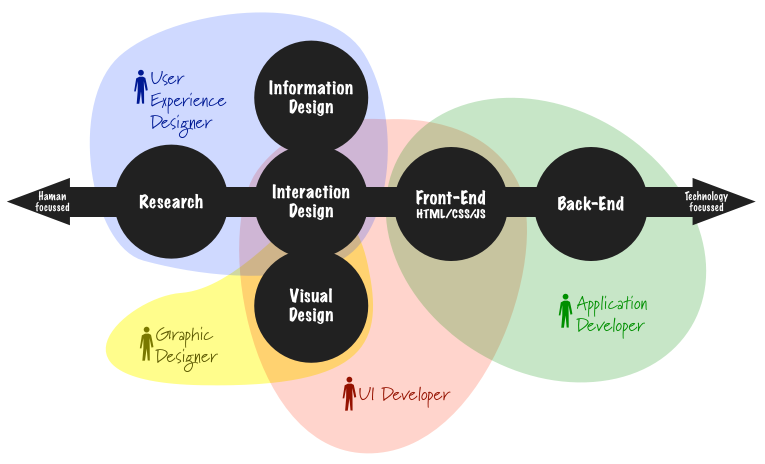
On top of this your looking for someone who can code app’s in numerous languages Swift (iOS), Java (Android), cross-platform languages like Xamarin and back end technologies like Javascript, .NET, Node.JS just to name but a few.
How could someone be talented enough to possess the skills of four different roles in the IT industry and be willing to work for the minimum amount?
If there was a chef out there that was a master of Italian, Asian and Indian cuisine do you think he’d also be the cheapest chef in town?
It is unlikely, but still possible that if your app idea has only a few select requirements, maybe the pre-existing back end that a cheaper developer provides meets could meet your app needs.
Therefore this option may allow you to hit the market in a cost effective way, however, as soon as your app reaches the stage that customising it in any way then you are going to have to remain in the confines of what the recycled/pre-existing back-end already provides… or start your app again from scratch.
An example of this could be you can include a chat feature to your app, but it won’t be able to customise how the chat box looks or what characters are used within it ie. emojis, other languages, etc. If you want a cheap app and you’re willing to give up a number of requirements to get something into the market, perhaps the “buffet” method could work for you.
So while the $15,000 option may seem like the cheap option to get to market, if your app becomes a success and you want to add features or change it’s look and feel… it’s likely at this stage you’ll be told the app needs to be completely rebuilt. It’s at this point the $15,000 option seems like it wasn’t the cheap option at all because initially developing your app from scratch would have saved you $15,000.
Below we have compiled some of the risks associated with building a cheap, $15,000 app and how the Appomate development team avoid those risks.
I want to build an app like Uber
We often get enquiries from clients who talk about a “simple” app idea they’d like to develop.
When asked what their idea involves, far too often we get responses like this.
“Just a simple app, something like Uber”
Uber created their “simple” app (then called UberCab) in San Francisco where they went live in 2009 with an MVP version (minimum viable product) of their app. Google and Benchmark pumped $258 million dollars of funding into it two years ago, but what would an MVP version of their app cost a budding app-renuer today?
Firstly let’s understand the concept. Building an app is not too different as the process of building a house would be. You need multiple teams to complete the job i.e. Electrician, plumber, bricklayer, architect, etc.
At Appomate we also have a number of talented development teams i.e. Android development team, iOS development team, Web app development team, etc.
So if we asked the team to come up with a “ballpark figure” to recreate some of the world’s most popular apps, what would that look like?
Uber, the San Francisco-based company made do with $50 million to build its product from scratch to current iteration. Then Google and Benchmark pumped $258 million more into it this past August.
Some people may view the app to be simple after 1-2 uses but Uber has many aspects to it that the casual app user may not identify.
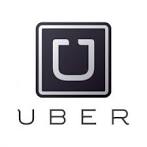 Uber, the San Francisco-based company made do with $50 million to build its product from scratch to current iteration. Then Google and Benchmark pumped $258 million more into it this past August.
Uber, the San Francisco-based company made do with $50 million to build its product from scratch to current iteration. Then Google and Benchmark pumped $258 million more into it this past August.
Some people may view the app to be simple after 1-2 uses but Uber has many aspects to it that the casual app user may not identify.
Because Uber works in real time, so the app needs to be primarily built in a “core engine” which multiple users can access it from multiple devices at multiple times.
This is so all parties drivers, users making trip requests, users about to make a trip request and Uber admin are all getting the same “real-data” as each other.
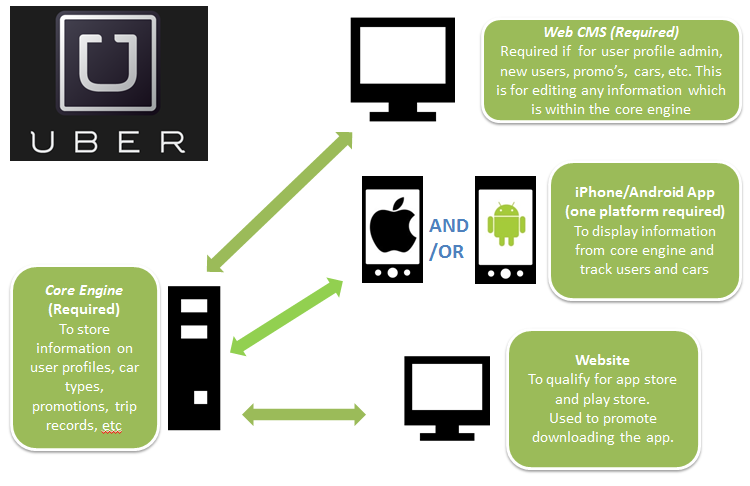
Within the Uber core engine these is a detailed multi-level structure for Uber’s many functions i.e. payments, products, different cities, promotions, etc. (see below). All of their features have basically their own app and database built for its sole purpose, this is done to make Uber incredibly fast to scale up or down and add or remove features.
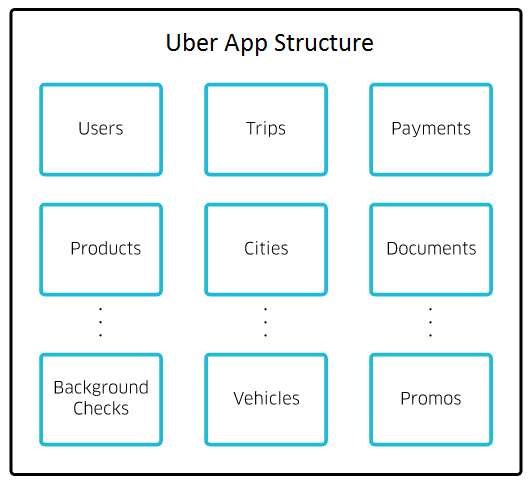
Google and Facebook also follow this strategy.
An MVP, however, would need to be developed on a much-simplified codebase.
Based on its early rounds, even a minimum viable product for Uber would have cost about $1 to $1.5 million to develop.
After assessing all of this, it is easy to see Uber isn’t what you would call a simple app.
So what would it cost to build MVP versions of the world’s most popular apps?
 Twitter isn’t necessarily difficult, but the layered features within the app would take a development team a while to get right.
Twitter isn’t necessarily difficult, but the layered features within the app would take a development team a while to get right.
The key to this project is it’s ‘experience layer’, the interface that makes a product relevant and intuitive for people to use while quickly demonstrating its value. The apps incorporation of feedback loops, analytics and its community largely amount for how successful this app is.
How much for a Twitter MVP?
$50,000-$250,000
Last Year Twitter yearly revenue was US$2.21 billion (2015)
 Instagram is slightly more complicated to build than Twitter due to a wider range of skills required for handle image-filtering and heavy backend image loads.
Instagram is slightly more complicated to build than Twitter due to a wider range of skills required for handle image-filtering and heavy backend image loads.
You could still build an Instagram-like product inexpensively compared to many other popular apps. A basic version of Instagram could take only three to six months.
How much for an Instagram MVP?
$100,000-$300,000
Last Year Twitter yearly revenue was US$2.21 billion (2015)
In around nine months of development and design time, you could create an app which includes the most important features of Facebook. This would be the least of your concerns, however.
It’s estimated that Mark Zuckerberg was spending $3,000 per month on hosting Facebook for the first year and roughly $10 million per month by 2006 as the app’s collection of photos, videos and messages grew exponentially in that time period.
Today Facebook has begun investing in power plants in order to host its user’s photos, videos and messages on its servers. It a fair estimate to say Facebook would be opening up a $30 million dollar hosting bill every month to handle its current volume.
How much for a Facebook MVP?
$300,000-$500,000
Last Year Facebook yearly revenue was US$17.928 billion (2015)
Key Takeaways
Although we’ve tried to shed some light on what drives the cost of app development
in relation to a basic version of all of these apps, developing a world-changing app requires a high amount of resources from both a development and maintenance position.
There’s an enormous amount of complexity that goes into each app’s environment: not just hosting costs but office infrastructure, product management and marketing to name a few.
But these apps have evolved over months and some over years.
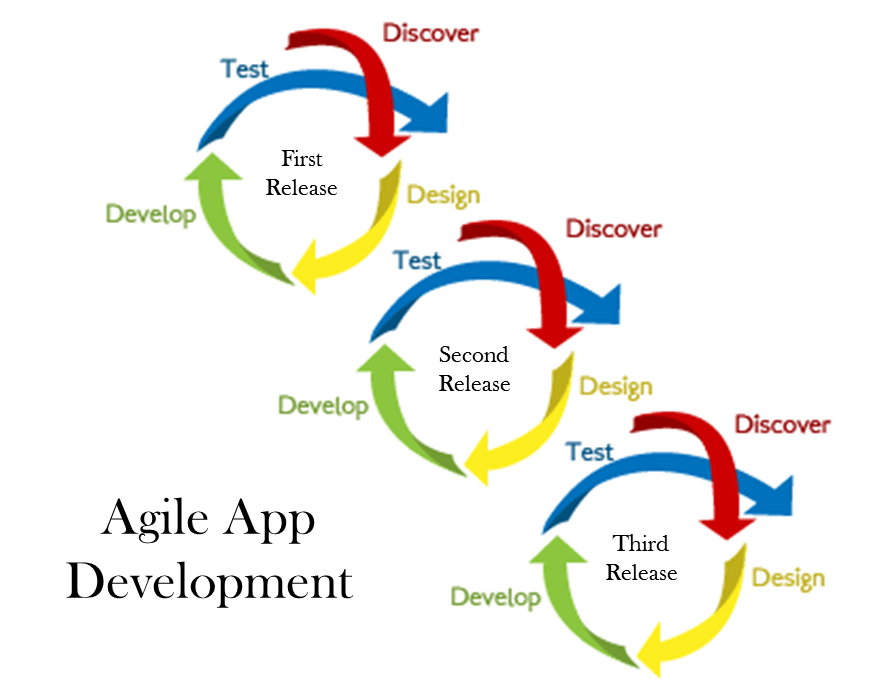
Building an app which includes only a few basic features which apps like Uber, Twitter, Instagram or Facebook make use of in their apps, getting it to the market and adding additional features based on user demand is a much smarter way to build an app.
A strategy like this is even possible even with a budget of $15,000-$25,000.
Take a look at an app we recently developed called Habit Recode which helps you form positive habits by charging a small fee if you don’t follow through on your intended goal for the day.
This app has 276 positive reviews by active users and almost to 5,000 downloads and this app was created for the same budget some companies charge for an “app workshop”
While starting a business based around an app is often a low-cost way to enter a marketplace compared to brick and mortar approach an app business will only become successful if you’re able to provide users with something they aren’t getting from other avenues.
However, the hard part isn’t necessarily the tech, its building and validating the product and adjusting it until you find a market fit.
Truthfully, you couldn’t replicate Uber, Twitter, Instagram or Facebook as it is today for a billion dollars. But you could potentially spend a few million on a “simple app” that copies Uber, Twitter or Instagram and no one will ever use.
The success of your app relies on you being able to build something remarkable, captivating and new; something with better features, different features or fewer features. That’s what the next Travis Kalanick, Jack Dorsey, Kevin Systrom, Mike Krieger or Mark Zuckerberg would do.
Saving 45% on Your App Feels Good, Doesn’t It?
While it is publicly available, some call the 45% rebate the Australian Government offers on Research and Development activities in Australia, the best kept secret when it comes to new app development. Most new app start ups are unaware of this powerful opportunity to offset the costs it takes to develop new technology.
This is yet another powerful reason to use a professional app development partner as they should understand how to help you leverage this opportunity to save big.
Here is more information on how you can take advantage of this opportunity and other government related grants and financial support.
The R&D tax incentive program helps you get up to 45% of your expenses back when you are in a loss position or up to 45% tax offset. Your app idea must be novel and qualify as a research and development project. Find more info here:
The Victorian government supports innovation by providing funding to entrepreneurs who focus on projects that simplify policy changes and aim at providing value to the public. Find more info here:
The city of Melbourne also offers grants to small businesses and start-ups. Download the Brochure
The Australian Government also provides financial assistance to by funding new businesses.
The Australian government has special programme called the Entrepreneurs’ Programme for budding entrepreneurs.
The Queensland government-funded “iLab” is one of Australia’s largest schemes for technology start-ups and has incubated over 100 start-ups.
The Western Australian government offers “The Innovator of the Year Award” granting the winner a $100,000 package.
Check what funding programs you qualify for, by answering a few questions in this link.
We hope this summary of government-backed funding support proves helpful to your app initiative. Appomate has recouped tens of thousands of dollars on individual projects using the R&D rebate.
It would be worth a call to understand more and see how you can save.
5 Elements Common to the World’s Most Successful Apps
What do the world’s most successful apps have in common? Our research team have spent some time digging into this question and here is what we have found. Your awesome app idea has a much greater probability of success if it incorporates these 5 elements of success:
1. Meet a Universal Need:
A universal need is something that transcends culture, language, location and time. These are things which make us all human beings, like:
- – The need for food and shelter
- – The need for safety and security
- – The need for connection and belonging
- – The need for recognition and appreciation
- – The need for skill mastery, achievement and freedom
For example, social networking and instant messenger apps are among the most successful category because they full fill the need for connection and belonging. Gaming apps help people feel skill mastery and give a sense of achievement. Sharing apps, like AirBnB and Uber, help people to save money and make money, and in doing so help meet their need for financial security and freedom.
2. Tap into the Habit Loop:
All successful apps tap into the human operating system by making some element of their app part of a regular routine for its users – in many cases, this leverages the first element of meeting a universal need. Successful apps utilise the habit loop of cue-routine-reward. They know and define the triggers or cues for users to use their app and include clear rewards for the habit. Read Sticky Apps: Decoding the Habit Loop to Ensure Success for more info on the Habit Loop for apps.
3. Incorporate Network Effects and Viral Loops:
The network effect is the phenomenon where a product becomes more valuable and useful when more people use it (this also plays an important role in your chosen revenue model, see next element). Facebook is great when all your friends are in there with you. Whatsapp is cool when all your friends, local and international, are using it as it makes communication quicker and easier. This motivates users to invite their contacts to use these app.
A viral loop is created when there is a clear need or incentive for 1 user to invite other users. The best apps build in incentives for their users to invite more users. Dropbox offers free storage when a user invites a friend to use Dropbox. Uber gives you taxi credit when you share your experience with your friends and invite them to use it. AirBnB offers Hosts money for introducing new hosts to AirBnB. What viral loop can you create to leverage the network effect?
4. Discover the Right Revenue Model:
Revenue split, subscription, in-app advertising and in-app purchases are the 4 most successful revenue models. Which model is the best fit for your app?
- – Revenue Split: apps that make the most money are the ones which helps others make a lot of money – for a small cut. These app companies help their customers make money, and in doing so, they split the revenue. Uber takes a 25% commission, AirBnB takes a 6 to 12% commission and Spotify up to 30% commission.
- – In-App Advertising: This is when you build an audience (see the Network Effect) and then charge advertisers for clicks and views by your users. Facebook makes billions of dollars every month from advertisement revenue.
- – Subscription: This is where you charge an ongoing fee for the service your app offers. Lumosity, a cognitive games app that focuses on improving different functions of your brain, provides access to the app’s brain games for an annual fee.
- – In-App Purchases: Make your app free and have valuable features (ensure Habit Loop is in your app) within your app for users to buy. Candy Crush Saga is a multi-billion dollar app which uses in-app purchases with only a 3% conversion rate. This demonstrates the power of the previous elements of Human Need, Habit Loop and Network Effects. Read Ways to Make Tons of Money from Apps for detailed information on revenue models you can leverage for your app’s success.
5. Focus on Your Niche:
Yes, we know, everyone wants their app to be globally dominant, but the starting point often requires focus on a particular niche and/or market. For example, Facebook initially had all its focus on Universities. Amazon was only selling books and then once it had the market, it started selling all products. This will allow you to learn fast and pivot (read Top Secret of Success: Billion Dollar Apps), market more effectively and build a proven model ready to scale. Make sure you have a clear niche target market you can get started with as it is through a targeted approach that you will learn what your users need and improve the success factor of your app.
How many of these items does your idea tick? The more, the better. Comment below if you are interested in our process for creating and installing these elements of success into your app.
Cracking the Code – What Developers Don’t Want You To Know
If you are outsourcing your app development to a developer, there are two aspects of app quality you must know about:
1. Functional Quality – the quality you can see, and;
2. Structural Quality – the quality you cannot see but acts as the foundation of your app
Most developers don’t want you to know about the second type. Let’s explore what that means for your app.
Functional quality is how well the app looks (appears visually) and works (buttons, sliders, etc). Functional quality focuses on whether the app performs against the documented features and requirements for your app.
Lack of functional quality shows up through poor UI and features that don’t work as they should. For the most part, you report these issues to your developer and they fix it.
Functional quality relies primarily on how well the developer understands the app requirements and, after fully developed, how well the app is tested. With a myriad of mobile devices, operating systems, and browsers, the app must be tested in multiple environments to ensure functional quality.
Structural quality, on the other hand, is not visible to you or to users as it forms the foundation upon which your app is built. Structural quality it is based on how good your developer is. If you are working with a single developer you will only get the knowledge and experience of that one person, if you are working with a development partner, they typically have an architect who oversees the structural aspect of the app. Therefore, when it comes to Structural quality and whether you use a freelance developer or a development partner really depends on how much risk tolerance you have (ie individual developer = higher risk of future problems).
Given many people have either been part of the home building or renovating process than have built an app, and given app development can be as personal a journey to their creators as their home is, it is useful to use home development as an analogy for your app quality development.
If functional quality is building your house to your specifications like a certain number of rooms, placement of windows, colours, fittings, measurements, etc., then structural quality is a strong and reliable the foundation and walls that support your cherished home.
Bad structural quality can have a very negative impact on the cost and time required to maintain your app through time. It may not be a big problem when your app is initially launched (or it may) but as you proceed with future updates, enhancements and general maintenance to the app, bad quality may show up in following ways:
1. Inconsistent App Bugs – certain bugs are hard to reproduce in any given scenario; the bug appears random
2. Bug Dominos – fixing one bug may lead to one or more bugs throughout the app
3. Big effort for Small change – small changes take way too long to fix because the app’s foundation is unsteady and hard to debug
4. App Crash- the app works fine most of the time, but it can crash suddenly for no known reason
These issues arise often times because the developer hasn’t followed a proper framework or app architecture.
In these instances, there may be little code documentation or code structure to identify different elements and features of your app. The absence of architecture and documentation make it very difficult for a new developer to understand your app and make changes to it when you decide you need another developer or yours disappears on your through time.
Trust that the chances are high that you will change developers a few times during the lifetime of your app as it grows and changes in line with your user demands. So how do you assess the code quality of your developer and ensure a solid foundation?
1. Talk to their clients. Ask them if they faced those above symptoms of bad code while they worked with the developer you are assessing.
2. Have a look at the code – A good code should look neat like a nice formatted word doc versus a word doc with text all over the place. You should be able to see English comments in different places explaining the code and the changes made. You will see white spaces, meaningful names used for variables and functions within the code
3. Ask the developer what framework and architecture they use in their coding. Ask them what is their process/tools for maintaining code versions.
4. Get a developer friend to review their code.
If you’d like an experienced app developer to take a look at your app code for testing or to give their opinions, simply call us today on 1300 781 794
5 Common Kickstarter Approaches to Create Your App
In the current ‘ ap-economy’, where everyone either has or is developing an app that is ‘the next BIG THING”, it is helpful to understand some of the most common ways to get started on the journey.
The following are five different approaches to getting your app idea kick-started.
Learn to Code
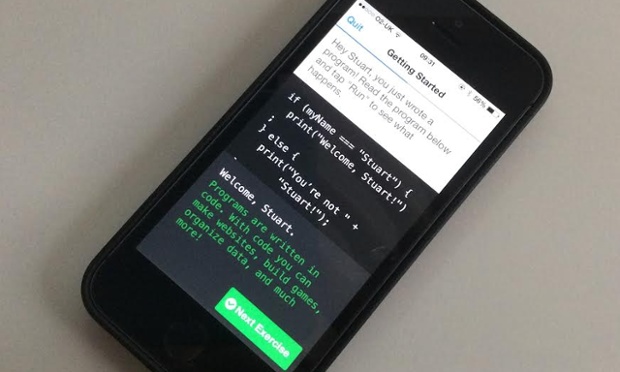 Yes, you heard it right, it’s not every app company that will encourage you to go a learn how to code an app yourself.
Yes, you heard it right, it’s not every app company that will encourage you to go a learn how to code an app yourself.
You can learn the art of coding through platforms like Udemy, Codecademy and get started with your relatively simple app idea.
Although this is a time-consuming method we’d have to agree it’s the best path to take if possible as nobody knows your app better than you.for those with much time on their hands, but no funds.
This strategy, however is for those with a lot time on their hands, but no funds.
Explore the DIY Platforms
 Are you looking to build a standard app with no sophisticated features but don’t want to learn how hardcore coding and are hindered by a lack of investment?
Are you looking to build a standard app with no sophisticated features but don’t want to learn how hardcore coding and are hindered by a lack of investment?
DIY tools like Appmakr, Appsme, and AppInventor may just be the right thing for you.
These tools make use of pre-built templates to quickly and easily create your app. Even better, many of them do not charge for using the service.
Build a Virtual Team
In this scenario, you are the project manager and you build your team of developers, architects, UX designers, CX analysts and testers through outsource platforms.
 A number of websites like Upwork.com, Freelancer.com and Guru.com provide easy access to a large pool of app developers from across the world.
A number of websites like Upwork.com, Freelancer.com and Guru.com provide easy access to a large pool of app developers from across the world.
There is an obvious cost advantage to this. The main challenge being you had better be a good project manager as the buck stops with you.
Coordinating resources around the world will take more time and effort than you might originally think – especially if this is your first time doing it.
BYOT:Build Your Own Team
 If you are really confident about the global success of your app idea – you are convinced you to have the next Uber or AirBnB – then you may seek investment and build up your own development team and management structure.
If you are really confident about the global success of your app idea – you are convinced you to have the next Uber or AirBnB – then you may seek investment and build up your own development team and management structure.
This approach is only for the brave and typically for those who have been down this path before, know how to raise millions in investment and know what they are doing.
Find a Development Partner
An experienced app development firm, which can act as your development partner, can provide the right mix to help you get your app from the idea stage to the profitability stage.
 Entrepreneurs looking for holistic support must perform a due diligence before partnering with an app development firm.
Entrepreneurs looking for holistic support must perform a due diligence before partnering with an app development firm.
This helps to obtain the highest level of quality, reliability and promptness in their app experience. This approach is for entrepreneurs who have a budget to get the project off the ground and typically is suited to those who are still performing a ‘day job’, while app development is happening in parallel.
This approach is for entrepreneurs who have a budget to get the project off the ground and typically is suited to those who are still performing a ‘day job’, while app development is happening in parallel.
Ultimately, the best app kickstarter approach depends really on the resources you have – time, skills and money. So, where will you start your App journey?
If you’d like to share your app idea with one of our app team call us today on 1300 781 794
